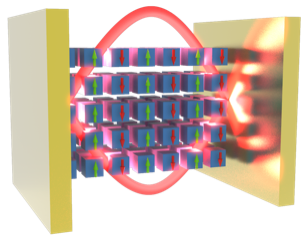
Optical resonator enhanced coupling of photons and spin-correlated excitations in a van der Waals magnetic crystal. Image created by Rezlind Bushati.
From The City College of New York’s Center for Discovery and Innovation and the Physics Department comes news of a new type of magnetic quasiparticle created by coupling light to a stack of ultrathin two-dimensional magnets. This achievement sprouting from a collaboration with the University of Texas at Austin lays the foundation for an emergent strategy to artificially design materials by ensuring their strong interaction with light.
"Implementing our approach with magnetic materials is a promising path towards efficient magneto-optical effects,” said CCNY physicist Vinod M. Menon, whose group led the study. “Achieving this goal can enable their use for applications in everyday devices like lasers, or for digital data storage.”
Dr. Florian Dirnberger, the lead author of the study, believes that their work exposed a largely unexplored realm of strong interactions between light and magnetic crystals. “Research in recent years brought forth a number of atomically flat magnets that are exceptionally well-suited to be studied by our approach,” he noted.
Looking ahead, the team plans to extend these investigations to understand the role of the quantum electrodynamical vacuum when quantum materials are placed into optical cavities. “Our work paves the way for the stabilization of novel quantum phases of matter that have no counterpart in thermodynamic equilibrium,” commented Edoardo Baldini, assistant professor at The University of Texas at Austin.
The development is reported in the current issue of “Nature Nanotechnology,” in a paper entitled “Spin-correlated exciton-polaritons in a van der Waals magnet.”
The research was funded by the National Science Foundation, Army Research Office and the CREST-IDEALS Center at CCNY.
About the City College of New York
Since 1847, The City College of New York has provided a high-quality and affordable education to generations of New Yorkers in a wide variety of disciplines. CCNY embraces its position at the forefront of social change. It is ranked #1 by the Harvard-based Opportunity Insights out of 369 selective public colleges in the United States on the overall mobility index. This measure reflects both access and outcomes, representing the likelihood that a student at CCNY can move up two or more income quintiles. In addition, the Center for World University Rankings places CCNY in the top 1.8% of universities worldwide in terms of academic excellence. Labor analytics firm Emsi puts at $1.9 billion CCNY’s annual economic impact on the regional economy (5 boroughs and 5 adjacent counties) and quantifies the “for dollar” return on investment to students, taxpayers and society. At City College, more than 16,000 students pursue undergraduate and graduate degrees in eight schools and divisions, driven by significant funded research, creativity and scholarship. CCNY is as diverse, dynamic and visionary as New York City itself. View CCNY Media Kit.
Jay Mwamba
p: 212.650.7580
e:
jmwamba@ccny.cuny.edu